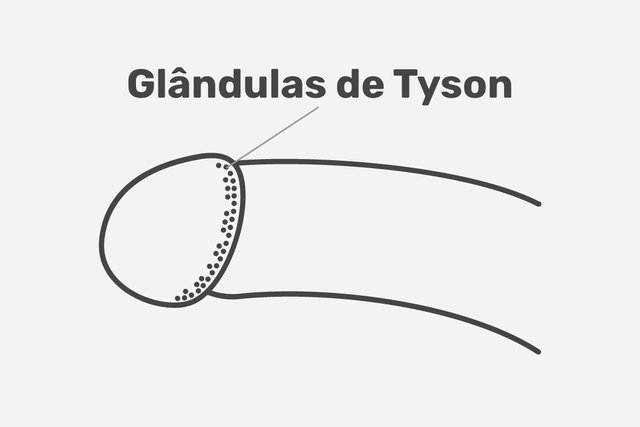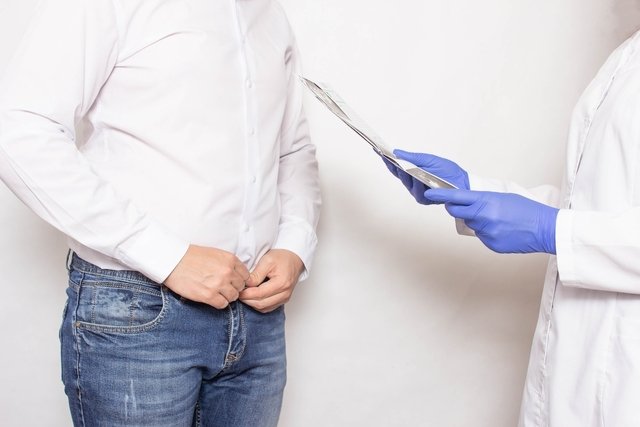Tyson’s glands are a type of structures in the penis that are present in all men, in the region around the glans. These glands are responsible for producing a lubricating liquid that facilitates penetration during intimate contact and are often invisible.
However, there are cases in which these glands are more visible, looking like small balls or white pimples around the head of the penis and are scientifically called pearly papules. Learn more about pearly papules.
Normally there is no need for treatment for Tyson’s glands, as it is a normal and benign change, however, if the man becomes uncomfortable and feels his self-esteem reduced, for example, he should go to the doctor so that he can the most appropriate treatment option will be suggested.

Tyson gland symptoms
In addition to being considered a normal and benign structure, Tyson’s glands do not lead to the appearance of signs or symptoms, but they can cause aesthetic discomfort for men.
Tyson’s glands are small white balls that appear underneath the head of the penis that do not itch or hurt, however, if any symptoms appear, it is important to go to the doctor so that the cause can be investigated, as in these cases the balls may not correspond to the Tyson’s glands. Discover other causes of lumps on the penis.
Don’t ignore your symptoms!
Tyson’s glands are structures present in the penis since birth, with no other cause related to their appearance and are considered normal.
However, they are usually best seen during erection and sexual intercourse, as they are responsible for the production of lubricating liquid that facilitates penetration.
Are pearly papules contagious?
Pearly papules, caused by the presence of Tyson’s glands, are not contagious and, therefore, are not considered a sexually transmitted disease.
These lesions can often be confused with genital warts caused by the HPV virus, and the only way to confirm the diagnosis is to consult a urologist.
What is the treatment like?
In most cases, Tyson’s glands do not need any type of treatment as they are benign and do not cause health problems. However, in some men, they can cause a major change in the image of the penis, which ends up making relationships difficult. In these cases, the urologist may recommend:
- Cauterization: This technique consists of using an electric current to burn the glands and remove them from the glans. Typically, this procedure is done using local anesthesia;
- Minor surgery: The doctor applies local anesthesia and then uses a scalpel to remove the glands. This technique can be performed in the office by an experienced urologist;
Although it would be easier to apply a medicine or ointment to eliminate Tyson’s glands, they do not yet exist. Furthermore, removing pearly papules can cause dryness of the penis, which becomes irritated and the skin breaks more easily. Therefore, treatment is almost always avoided and not recommended by the urologist.
Is there home treatment?
There are also several home treatment options, with acids and remedies for warts and calluses, however, they are not safe for health, as they can cause serious irritation to the penis and should be avoided.
In all cases, it is always advisable to consult a urologist before attempting any type of home treatment.
Female Tyson’s gland
Tyson’s glands are exclusively male, present at the base of the glans penis, that is, women do not have this type of gland. Therefore, there is no female Tyson gland.
If a woman has spots, white pimples or warts in the intimate area, she should consult a gynecologist, as there are health conditions that can cause these symptoms, such as HPV, for example. Know how to identify HPV in women.
Bibliography
- DIONÍSIO, Marco; GENTILE, Leonardo; DAMIÃO, Ronaldo. Male genital skin diseases. Electronic magazine of the SBU teaching and training commission. Vol 4. 1 ed; 21-31, 2016
- DERMNET. Pearly penile papules. Available at: <https://dermnetnz.org/topics/pearly-penile-papules>. Accessed on October 28, 2022
- ALDAHAN, Adam S.; BRAH, Tara K.; Nouri, Keyvan. Diagnosis and Management of Pearly Penile Papules. American Journal of Men’s Health. Vol 12. 3 ed; 624-627, 2018
- AUSTRALIAN FAMILY PHYSICIAN. Penile appearance, lumps and bumps. Available at: <https://www.racgp.org.au/afp/2013/may/penile-appearance>. Accessed on October 28, 2022

Sign up for our newsletter and stay up to date with exclusive news
that can transform your routine!
Warning: Undefined array key "title" in /home/storelat/public_html/wp-content/plugins/link-whisper-premium/templates/frontend/related-posts.php on line 12
Warning: Undefined array key "title_tag" in /home/storelat/public_html/wp-content/plugins/link-whisper-premium/templates/frontend/related-posts.php on line 13




